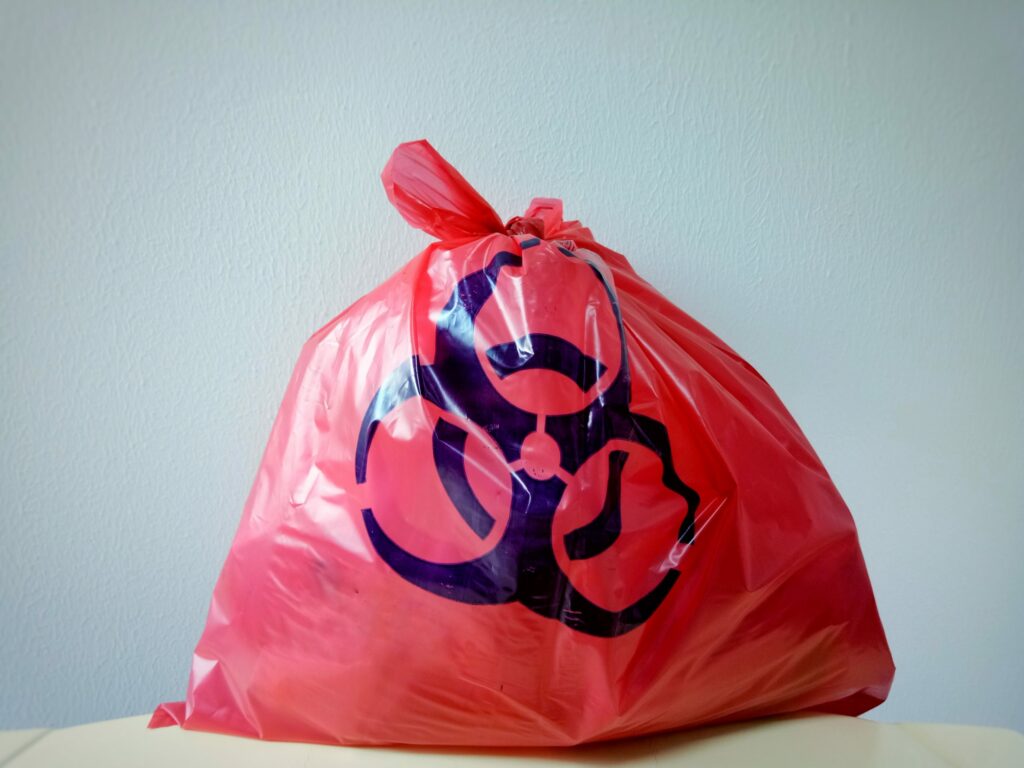Biohazard waste, also known as infectious or biomedical waste, is, by definition, any type of waste that involves infectious or potentially infectious materials or substances. And, while learning biohazard waste’s definition from a broad view is helpful, it can be even more impactful to consider different waste products and what subcategory of biohazard waste they fall into.
What are Some Examples of Biohazard Waste?
Bodily fluids, such as blood, infectious agents, pathological waste, animal waste, sharps and DNA or RNA samples.
Why is It Important to Know What is Considered Biohazard Waste?
Proper handling will avoid spreading infection. Therefore, it’s important to know the different types of biohazard waste in order to safely handle and dispose of it.
Categories of Biohazard Waste
There are five categories of biohazard waste. Each form is separated, identified, sterilized and recycled appropriately to minimize exposure and risk to the environment and general population.
- Solid waste includes non-sharp items contaminated with any bodily fluids or biological material. For example, gloves, pipettes, towels, or culture.
- Liquid waste includes bulk quantities of blood or bodily fluids.
- Sharps waste includes any materials that can puncture or pierce through skin and is contaminated with biological material that can risk transmission or release to the environment. For example, needles, syringes, scalpels, microscopic slides, small broken glass or tubes.
- Pathological waste includes human organs, tissues and body parts with the exception of teeth.
- Microbiological waste includes infectious organisms, microorganisms and biologicals.
Let’s go over each of these categories of biohazard waste right now in greater detail so you have a more developed understanding of them all and how to distinguish between them.
1. Liquid Biohazard Waste
Liquid biohazard waste includes any liquid waste from humans or animals that has a high chance of spreading disease or infection if handled incorrectly. Examples include:
- Blood
- Blood elements
- Bodily fluids
- Semi-liquid materials
If the amount of liquid is less than 25 milliliters in volume, you can dispose of it as normal solid waste. But if the volume is greater than 25 milliliters, you’ll need to dispose of it using a different, more controlled method.
2. Dry Biohazard Waste
Dry, or solid, biohazard waste is any waste that contacts human or animal materials. Examples include:
- Personal Protective Equipment (PPE)
- Petri dishes
- Towels or linens
- Pipettes
- Waste from viruses, bacteria and live or inactive vaccines
When preparing for disposal, place your dry biohazard waste in a labeled container with an autoclave bag. The waste is shipped off, autoclaved (disinfected using a heated steam system) and set to a medical waste landfill facility.
3. Sharps
Sharps are considered biohazard waste. Any device that can puncture skin is considered shar and can potentially spread infectious materials or disease. Examples include:
- Needles
- Scalpels
- Blades
- Slides
Your sharps have their own containers designed specifically for them. These help protect from injuries and avoid further contact. There are different sized containers for different sized sharps. A medical waste disposal company will pick up and dispose of your sharps in a safe, controlled environment.
4. Pathological
Human anatomical specimens are considered pathological biohazard waste. Waste material from biopsies or body parts removed from surgeries and autopsies are considered pathological. They all could include infectious bacteria or agents, and include human or animal:
- Organs
- Tissue
- Other body parts removed or biopsied
To prevent leaks, spills and the spread of infectious materials, you should double bag your pathological biohazard waste. To further protect yourself and the waste, you should then place it in a sturdy plastic container. Pathological waste needs to either be chemically treated or incinerated.
5. Microbiological
Microbiological biohazard waste can contain infectious organisms, microorganisms and biologicals. Agents created for antibiotic or biological use are also considered microbiological waste. Examples include:
- Disposable culture dishes
- Specimen cultures
- Discarded viruses
- Devices that mixed cultures
- Waste from biologicals or serums
- Waste from clinical research that involve spreadable infectious materials
Autoclaving is a common form of disposal for microbiological waste. Once they are stored, they are then treated based on the category of waste they fall under, such as sharps, solid or liquid waste.
Get Help With Biohazard Waste Management & Disposal
All biohazardous waste has the potential to spread infectious agents. It’s important to know what falls under biohazardous waste and what specific category. That way, you can properly dispose of it.
Contacting a medical waste disposal company and following guidelines will ensure all your biohazard waste is safely and carefully treated and disposed of to prevent possible dangerous accidents.
MedPro Disposal can help with your biohazard waste disposal needs.



